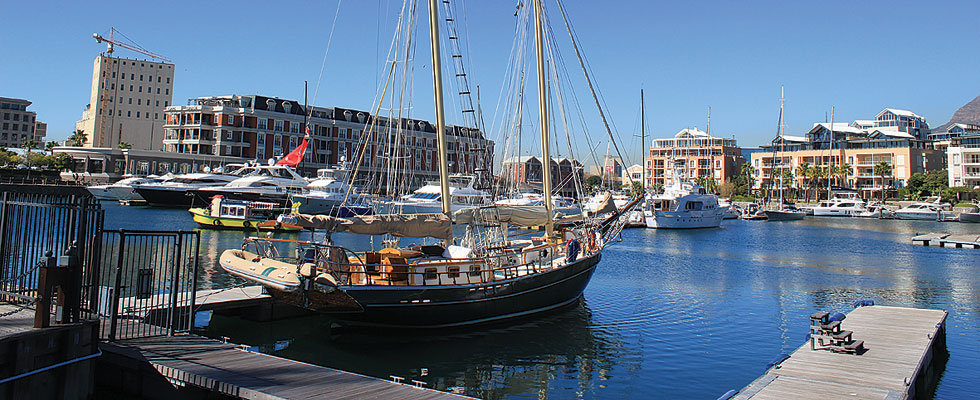
WHILE having a light, delicious lunch at the Two Oceans Aquarium Restaurant, Victoria and Alfred Waterfront at Cape Town Harbour, I was amazed to see a seal sunning itself on a plank raised decking no more than three metres away from where I – and scores of other folk – ate, drank and chatted on a blissfully warm, cloudless day.
Travel with Dusty Miller
This is one of the many places in the harbour that Cape Fur Seal s (also known as the South African Fur Seal and Brown Seal) have decided is a good sun-bathing spot!
These likeable creatures are normally found in large colonies or rookeries (usually 500 to 1 500 strong) around the Cape and extending up to northern Namibia, especially on rugged, rocky offshore islands.
They are highly opportunistic and the harbour is a great place to get scraps thrown off fishing boats and other ocean-going craft. It also offers much protection from their main predator, the Great White Shark.
Adult males are just over two metres long and weight 200-300kg; females are much smaller at around 1,5m and weigh on at between 50 and 75kg.
They tend to be quite friendly towards scuba divers in the water but can get quite panicky among people on land and could turn dangerous.
They have every right to panic among man. They were extensively hunted for centuries in Australia and South Africa and are even now still culled up the coast in Namibia: cubs are clubbed for their soft warm fur and adult males for their genitalia, regarded as aphrodisiacs in the Far East. Other fauna around the harbour includes countless Kelp Gulls and also Hartlaub’s Gulls. One of the latter patiently perched on a parapet between me and the sea and waited for me to leave him a chip or two!
- Chamisa under fire over US$120K donation
- Mavhunga puts DeMbare into Chibuku quarterfinals
- Pension funds bet on Cabora Bassa oilfields
- Councils defy govt fire tender directive
Keep Reading
(In a future issue I’ll look more closely at the birds of the Cape) The Ferryman’s Tavern and Mitchell’s Scottish Ale House are two welcoming pubs among the many hotels, restaurants, cafes and fast food outlets in the harbour and throughout the neighbouring shopping mall.
These were the first two businesses to be launched under the banner of the V&A Waterfront.
The original building was erected in the 1860s and was part of a warehouse. Near the Clock Tower was Bertie’s Landing, named after a well-known sailor, Bertie Reed. This was a favourite watering hole in Victorian days.
Before the construction of the Swing Bridge, pub-crawlers had to cross the “cut” in a small rowing boat called the Penny Ferry to get to Ferryman’s and Mitchell’s on the other side. Bertie’s was, perhaps sadly, demolished to make way for the Robben Island Museum and Nelson Mandela Gateway ticket office.
When I first visited Cape Town in 1977 on the last sailing of the RMS Windsor Castle from Durban to (in my case) the Canary Islands—it went on to Southampton – I was told by everyone in this country who knew the Cape to try find time to eat at the old Harbour Café.
I did, despite the wonderful gourmet chefs on Union-Castle mail ships, and can still clearly remember eating memorably good seafood for next-to-nothing at an eatery which was quite similar to British transport cafes.It had originally opened in 1903 on the site of Cape Town’s first post office, opening as a tea room, later known as the Crow’s Nest.
Today it’s the Hildebrand Restaurant and is classed as a Ristorante Italiano, an accolade only handed out by the President of Italy. Anything to do with the Hildebrand family who pioneered and farmed (once upon a time, I assume) the Burma Valley in Manicaland?
You’ve probably seen Cape Union Mart advertising rugged outdoor clothing on DSTV and their head office is in a red corrugated iron building in the harbour where the firm of Louw and Halvorsen, in the early 1900s, built many wooden boats, tugboats and other small craft. Survivors can still be seen around the Waterfront today.
There are three moving bridges in the Waterfront, the oldest (1882) is at the entrance to the Robinson Graving Dock and opens and closes sideways to allow ships in for repair and maintenance. Another was built in 1996 to give direct access for pedestrians from the CBD and Cape Grace Hotel. This is a drawbridge-type operation, vertically opening, known in military history as a bascule bridge.
The spectacular Cape Grace Hotel has a Bascule Bar and I sat outside on its stoep, gawping in admiration at the multi-million dollar ocean-going yachts tied up at the international marina and enjoying a glass of chilled KWV sauvignon-blanc wine for half-an-hour or so during one of my expeditions.
I’ve already mentioned the Swing Bridge over the Cut which opened in 1997. Prior to that, anyone wanting to get from one side to the other had to pay the ferryman one penny (later 2c) to cross.
Abdul, the first ferryman who spent almost his whole working life in that job, reckoned that he had rowed the equivalent of twice round the world while carrying out his necessary duties. [email protected]











